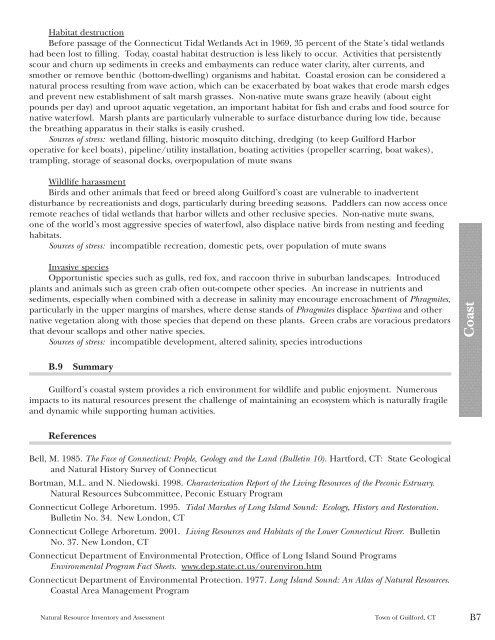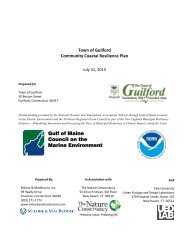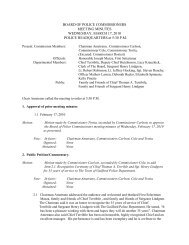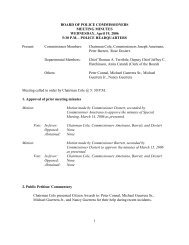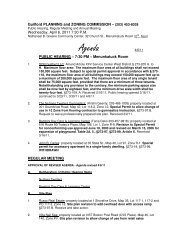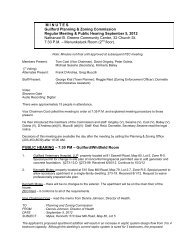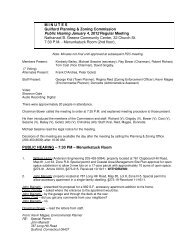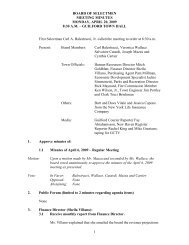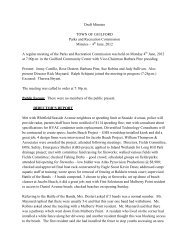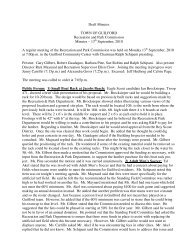Natural Resource Inventory and Assessment - Town of Guilford
Natural Resource Inventory and Assessment - Town of Guilford
Natural Resource Inventory and Assessment - Town of Guilford
You also want an ePaper? Increase the reach of your titles
YUMPU automatically turns print PDFs into web optimized ePapers that Google loves.
Habitat destruction<br />
Before passage <strong>of</strong> the Connecticut Tidal Wetl<strong>and</strong>s Act in 1969, 35 percent <strong>of</strong> the State’s tidal wetl<strong>and</strong>s<br />
had been lost to filling. Today, coastal habitat destruction is less likely to occur. Activities that persistently<br />
scour <strong>and</strong> churn up sediments in creeks <strong>and</strong> embayments can reduce water clarity, alter currents, <strong>and</strong><br />
smother or remove benthic (bottom-dwelling) organisms <strong>and</strong> habitat. Coastal erosion can be considered a<br />
natural process resulting from wave action, which can be exacerbated by boat wakes that erode marsh edges<br />
<strong>and</strong> prevent new establishment <strong>of</strong> salt marsh grasses. Non-native mute swans graze heavily (about eight<br />
pounds per day) <strong>and</strong> uproot aquatic vegetation, an important habitat for fish <strong>and</strong> crabs <strong>and</strong> food source for<br />
native waterfowl. Marsh plants are particularly vulnerable to surface disturbance during low tide, because<br />
the breathing apparatus in their stalks is easily crushed.<br />
Sources <strong>of</strong> stress: wetl<strong>and</strong> filling, historic mosquito ditching, dredging (to keep <strong>Guilford</strong> Harbor<br />
operative for keel boats), pipeline/utility installation, boating activities (propeller scarring, boat wakes),<br />
trampling, storage <strong>of</strong> seasonal docks, overpopulation <strong>of</strong> mute swans<br />
Wildlife harassment<br />
Birds <strong>and</strong> other animals that feed or breed along <strong>Guilford</strong>’s coast are vulnerable to inadvertent<br />
disturbance by recreationists <strong>and</strong> dogs, particularly during breeding seasons. Paddlers can now access once<br />
remote reaches <strong>of</strong> tidal wetl<strong>and</strong>s that harbor willets <strong>and</strong> other reclusive species. Non-native mute swans,<br />
one <strong>of</strong> the world’s most aggressive species <strong>of</strong> waterfowl, also displace native birds from nesting <strong>and</strong> feeding<br />
habitats.<br />
Sources <strong>of</strong> stress: incompatible recreation, domestic pets, over population <strong>of</strong> mute swans<br />
Invasive species<br />
Opportunistic species such as gulls, red fox, <strong>and</strong> raccoon thrive in suburban l<strong>and</strong>scapes. Introduced<br />
plants <strong>and</strong> animals such as green crab <strong>of</strong>ten out-compete other species. An increase in nutrients <strong>and</strong><br />
sediments, especially when combined with a decrease in salinity may encourage encroachment <strong>of</strong> Phragmites,<br />
particularly in the upper margins <strong>of</strong> marshes, where dense st<strong>and</strong>s <strong>of</strong> Phragmites displace Spartina <strong>and</strong> other<br />
native vegetation along with those species that depend on these plants. Green crabs are voracious predators<br />
that devour scallops <strong>and</strong> other native species.<br />
Sources <strong>of</strong> stress: incompatible development, altered salinity, species introductions<br />
B.9 Summary<br />
<strong>Guilford</strong>’s coastal system provides a rich environment for wildlife <strong>and</strong> public enjoyment. Numerous<br />
impacts to its natural resources present the challenge <strong>of</strong> maintaining an ecosystem which is naturally fragile<br />
<strong>and</strong> dynamic while supporting human activities.<br />
References<br />
Bell, M. 1985. The Face <strong>of</strong> Connecticut: People, Geology <strong>and</strong> the L<strong>and</strong> (Bulletin 10). Hartford, CT: State Geological<br />
<strong>and</strong> <strong>Natural</strong> History Survey <strong>of</strong> Connecticut<br />
Bortman, M.L. <strong>and</strong> N. Niedowski. 1998. Characterization Report <strong>of</strong> the Living <strong>Resource</strong>s <strong>of</strong> the Peconic Estruary.<br />
<strong>Natural</strong> <strong>Resource</strong>s Subcommittee, Peconic Estuary Program<br />
Connecticut College Arboretum. 1995. Tidal Marshes <strong>of</strong> Long Isl<strong>and</strong> Sound: Ecology, History <strong>and</strong> Restoration.<br />
Bulletin No. 34. New London, CT<br />
Connecticut College Arboretum. 2001. Living <strong>Resource</strong>s <strong>and</strong> Habitats <strong>of</strong> the Lower Connecticut River. Bulletin<br />
No. 37. New London, CT<br />
Connecticut Department <strong>of</strong> Environmental Protection, Office <strong>of</strong> Long Isl<strong>and</strong> Sound Programs<br />
Environmental Program Fact Sheets. www.dep.state.ct.us/ourenviron.htm<br />
Connecticut Department <strong>of</strong> Environmental Protection. 1977. Long Isl<strong>and</strong> Sound: An Atlas <strong>of</strong> <strong>Natural</strong> <strong>Resource</strong>s.<br />
Coastal Area Management Program<br />
<strong>Natural</strong> <strong>Resource</strong> <strong>Inventory</strong> <strong>and</strong> <strong>Assessment</strong> <strong>Town</strong> <strong>of</strong> <strong>Guilford</strong>, CT B7<br />
Coast


